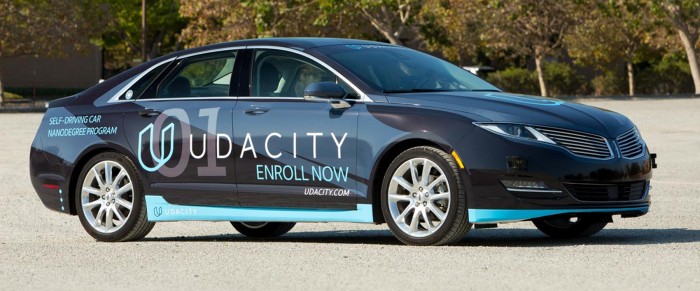The Creator of Google’s Self-Driving Car Now Competes with It
If Sebastian Thrun’s third self-driving-car project is as influential as his first two, we’ll be tearing up our driver’s licenses sooner than anyone expected.
As a robotics professor at Stanford, Thrun won the Pentagon’s 2005 contest for self-driving vehicles that fired the starting gun in the race to commercialize the technology. He then established and led Google’s car project, which has racked up more autonomous miles than any competitor.
The one he’s working on now comes from an unlikely place: his online education startup Udacity. And it has similarities to his past efforts—a Lincoln sporting Udacity logos, cameras, and spinning lasers can be seen driving around the Bay Area. But the software piloting this car will be given away free, in open-source form. Data collected by the car as it drives around is also being released for anyone to use.

Drawing an analogy with the smartphone market, Thrun argues that this unusual tactic will accelerate the development of self-driving cars. Google and other companies working on the technology usually keep their code and data to themselves.
“You could say that Google built the iPhone [of self-driving cars] and we are building Android,” says Thrun. “Making that software available for everybody reduces the burden for any newcomer to build their own vehicle, very much like Android accelerated the development of smartphones.”
Udacity started its car project to accompany a new course on autonomous-car engineering starting in January. Udacity engineers wrote the code needed to start testing the car. The company is now soliciting outside contributions by offering prizes for the best responses to a series of challenges, such as improving the car’s ability to interpret data from its cameras. (Some data from outside contributions is already inside Udacity’s vehicle.) Students in the course will also contribute code during the nine-month program, which costs $2,400.

Ironically, Udacity’s project has backing from some of the very same companies Thrun hopes his car will put under new competitive pressure. The company creates courses it calls “nanodegrees” in areas where the technology industry struggles to hire workers with the right skills. Corporations can partner with Udacity to help create course material, and in return are first in line to recruit graduates looking for a job.
Udacity lists 14 “hiring partners” for its self-driving-car program, including BMW, Mercedes, and Uber’s self-driving-truck division, Otto.
Alain Kornhauser, director of transportation research at Princeton University, says Udacity’s open approach is welcome. He says that if the industry can develop ways to share data from test drives, the technology will more quickly get to the point where it can significantly reduce road deaths, something that companies working on automated driving like to cite as an eventual benefit.
Because car accidents are relatively rare and road and traffic conditions so varied and complex, it takes a lot of miles for a system to experience all the challenging “corner cases” that it needs to cope with. “We need to find ways to share critical information so that everyone doesn’t make the same mistakes,” says Kornhauser.
Guidelines for self-driving cars released by the U.S. Department of Transportation last month asked companies to develop plans to share some data (See “U.S. Wants Makers of Driverless Cars to Prove They’re Safe”). So far, though, no company has said it’s ready to hand any over. “What I see in the market right now is a lot of companies building silos of software and data for themselves and very little sharing of data,” says Thrun.
Keep Reading
Most Popular
Large language models can do jaw-dropping things. But nobody knows exactly why.
And that's a problem. Figuring it out is one of the biggest scientific puzzles of our time and a crucial step towards controlling more powerful future models.
The problem with plug-in hybrids? Their drivers.
Plug-in hybrids are often sold as a transition to EVs, but new data from Europe shows we’re still underestimating the emissions they produce.
Google DeepMind’s new generative model makes Super Mario–like games from scratch
Genie learns how to control games by watching hours and hours of video. It could help train next-gen robots too.
How scientists traced a mysterious covid case back to six toilets
When wastewater surveillance turns into a hunt for a single infected individual, the ethics get tricky.
Stay connected
Get the latest updates from
MIT Technology Review
Discover special offers, top stories, upcoming events, and more.